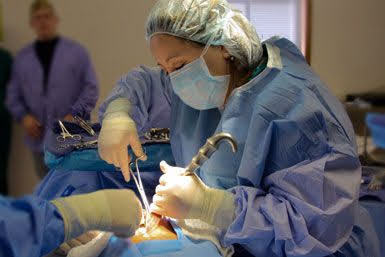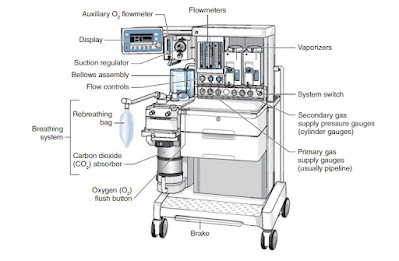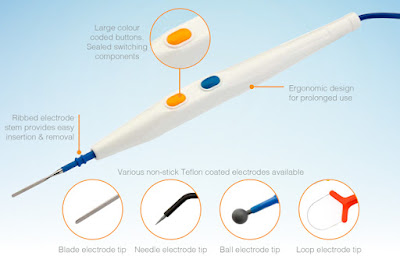How to clean , disinfect and sterilize laparoscopic instruments?
Processing of Laparoscopic Instruments
Glutaraldehyde formulations are the most popular chemical germicides for high-level disinfection of laparoscopic and endoscopic equipment.
Optimal processing of LI involves several steps that reduce the risk of transmitting infection. These are :
1) Dismantling
Dismantle all removable parts for thorough cleaning.
2)Decontamination
The procedure begins in the theatre itself using the nursing staff wiping off visible blood tissue and body fluids in the instruments with a damp sterile sponge. At the conclusion of this all soiled or contaminated instruments should be placed in a container containing a disinfectant solution such as 0.5% chlorine and allowing them to soak for Ten minutes.
3) Precleaning
Following the instruments reach the sterile supplies processing area, which is preferably a controlled environment, a pre-cleaning treatment with an enzymatic method ( protease, amylase, lipase etc.) is recommended
4) Cleaning
Ultrasonic cleaning is 16 times better than hand-cleaning. The instruments are placed in the ultrasonic unit for 10-15 minutes and use a neutral pH solution.
Immediately After Use:
- Rinse: Rinse instruments under running water to remove blood, tissue, and other debris immediately after use.
Manual Cleaning:
- Soak: Place instruments in a cleaning solution (enzymatic cleaner) for a specified time to loosen debris.
- Scrub: Use soft brushes or sponges to scrub all surfaces, including crevices and lumens of hollow instruments. Avoid abrasive materials that can damage surfaces.
Automated Cleaning:
- Ultrasonic Cleaner: Use an ultrasonic cleaner for thorough cleaning. Follow manufacturer instructions regarding the cleaning solution and cycle duration.
Final Rinse:
- Rinse instruments thoroughly with sterile or distilled water to remove any remaining cleaning agents.
5) Drying
This really is ideally achieved by using an air gun that blows all the water droplets off the surfaces of instruments or by using an oven.
6) Sterilization
There are three sterilization processes available to us - steam, ethylene oxide and glutaraldehyde.
Flash / vacuum steam sterilization
Laparoscopes may be sterilized by flash or vacuum steam sterilization. Before sterilization, all instruments that are insulated, all silicone tubing, and all sorts of cords ought to be doubly covered with a cloth to prevent connection with the hot metallic container. They are then put into the autoclave. Flash sterilization is carried out at 135 0C at 30 psi pressure for 60 minutes. This method requires post-vacuum and dry cycles. The instruments should rest on a sterilizer rack for 45 minutes to prevent water condensation about the lens.
Gas sterilization
Endoscopic instruments may be sterilized with either cold or warm EO gas, with respect to the manufacturer’s instructions. With cold gas, the temperatures are set at 85 °C and also the instruments are subjected for 4 hours and 30 minutes. Aeration must then follow for 12 hours. Warm gas sterilization happens at 145 °C for 2 hour 30 minutes, followed by 8 hours aeration. The benefits of EO are how the items aren't damaged, it's non-corrosive to optics also it permeates porous material. Its main disadvantages are its cost, toxicity, the requirement for aeration and being a longer process.
High level disinfection
Agents that are employed for HLD include 2% glutaraldehyde, 6% stabilized hydrogen peroxide and per acetic acid . Glutaraldehyde has got the benefits of having good biocidal activity, non-corrosive to optics and it is active in the presence of protein. Fiberoptic light cords and telescopes have to be soaked in 2% glutaraldehyde not less than Ten minutes. Soaking should not exceed Twenty minutes. The endo camera could also disinfected by 10 minutes submersion in 2% glutaraldehyde.
7) Storage:
For optimal storage, sterile packs are put in closed cabinets in areas that aren't heavily trafficked, have moderate temperatures, and are dry or of low humidity.
- Clean Environment: Store sterilized instruments in a clean, dry environment to prevent contamination.
- Regular Monitoring: Check storage conditions regularly to ensure instruments remain sterile.
Additional Considerations
- Manufacturer Instructions: Always follow the manufacturer’s instructions for cleaning, disinfecting, and sterilizing specific instruments.
- Staff Training: Ensure all personnel involved in instrument processing are trained in proper techniques and protocols.
- Documentation: Maintain records of cleaning, disinfection, and sterilization processes for quality assurance.



